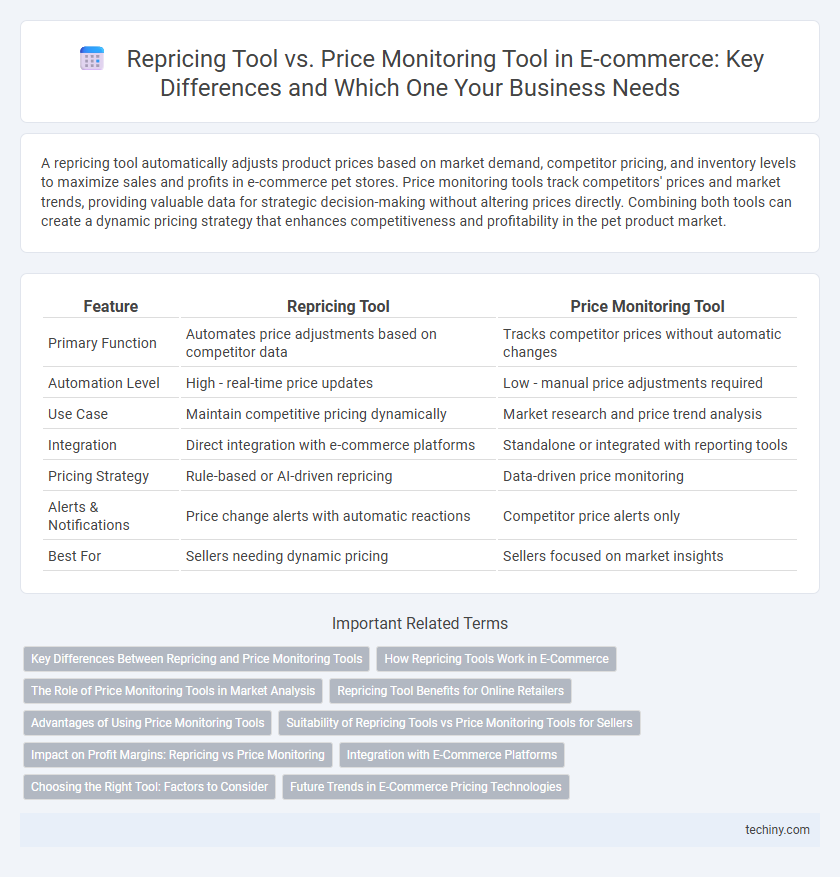A repricing tool automatically adjusts product prices based on market demand, competitor pricing, and inventory levels to maximize sales and profits in e-commerce pet stores. Price monitoring tools track competitors' prices and market trends, providing valuable data for strategic decision-making without altering prices directly. Combining both tools can create a dynamic pricing strategy that enhances competitiveness and profitability in the pet product market.
Table of Comparison
| Feature | Repricing Tool | Price Monitoring Tool |
|---|---|---|
| Primary Function | Automates price adjustments based on competitor data | Tracks competitor prices without automatic changes |
| Automation Level | High - real-time price updates | Low - manual price adjustments required |
| Use Case | Maintain competitive pricing dynamically | Market research and price trend analysis |
| Integration | Direct integration with e-commerce platforms | Standalone or integrated with reporting tools |
| Pricing Strategy | Rule-based or AI-driven repricing | Data-driven price monitoring |
| Alerts & Notifications | Price change alerts with automatic reactions | Competitor price alerts only |
| Best For | Sellers needing dynamic pricing | Sellers focused on market insights |
Key Differences Between Repricing and Price Monitoring Tools
Repricing tools automatically adjust product prices based on competitor pricing and market demand to maintain competitiveness and maximize profits. Price monitoring tools track and analyze competitor prices and market trends without making pricing changes, providing valuable data for strategic decision-making. The key difference lies in automation: repricing tools execute price changes dynamically, whereas price monitoring tools offer insights to inform manual pricing strategies.
How Repricing Tools Work in E-Commerce
Repricing tools in e-commerce automatically adjust product prices based on competitor pricing, demand fluctuations, and inventory levels using dynamic algorithms to maximize sales and profit margins. These tools continuously scan market data, analyze pricing trends, and implement real-time price changes to maintain competitiveness without manual input. In contrast to price monitoring tools that solely track competitor prices, repricing tools actively execute price adjustments to optimize positioning in the marketplace.
The Role of Price Monitoring Tools in Market Analysis
Price monitoring tools play a critical role in market analysis by continuously tracking competitor pricing, stock levels, and promotional activities, enabling e-commerce sellers to make data-driven decisions. These tools collect real-time market data to identify pricing trends, demand fluctuations, and potential opportunities for optimization. Unlike repricing tools that automatically adjust prices, price monitoring tools provide comprehensive insights that guide strategic pricing and inventory management.
Repricing Tool Benefits for Online Retailers
Repricing tools enable online retailers to automatically adjust product prices based on competitor pricing, market demand, and inventory levels, maximizing profitability and sales velocity. These tools provide real-time price updates, ensuring competitive positioning without manual intervention, which is crucial in dynamic e-commerce environments. Enhanced pricing strategies driven by repricing software help retailers maintain margin control while responding swiftly to market fluctuations.
Advantages of Using Price Monitoring Tools
Price monitoring tools provide real-time tracking of competitor prices, enabling e-commerce sellers to make informed pricing decisions swiftly. These tools offer detailed market insights and historical price trends, helping businesses identify opportunities and avoid price wars. Enhanced with advanced analytics, price monitoring tools optimize revenue by ensuring products remain competitively priced without frequent manual adjustments.
Suitability of Repricing Tools vs Price Monitoring Tools for Sellers
Repricing tools are ideal for sellers seeking automated price adjustments to stay competitive in dynamic markets, enabling real-time price changes based on competitor activity and inventory levels. Price monitoring tools suit sellers who prioritize tracking competitor pricing and market trends without immediate price changes, providing valuable data analytics for informed decision-making. Combining both tools can optimize pricing strategies, but repricing tools are more suitable for active price management, while monitoring tools cater to strategic pricing analysis.
Impact on Profit Margins: Repricing vs Price Monitoring
Repricing tools dynamically adjust product prices in real-time based on competitor pricing, maximizing profit margins by capturing optimal price points and responding swiftly to market changes. Price monitoring tools track competitor prices without automatic adjustments, offering valuable insights but requiring manual intervention to update prices, which can delay responsiveness and limit margin optimization. Integrating repricing capabilities directly influences profit margins more effectively than price monitoring alone, as it ensures prices remain competitive and aligned with market demand instantly.
Integration with E-Commerce Platforms
Repricing tools offer seamless integration with major e-commerce platforms like Shopify, Amazon, and eBay, enabling automatic price adjustments based on real-time market data to maximize sales and profits. Price monitoring tools primarily focus on tracking competitors' prices and market trends, providing valuable insights but often requiring manual updates or third-party plugins for full platform compatibility. Efficient integration in repricing tools supports dynamic pricing strategies, while price monitoring tools emphasize comprehensive data collection to inform strategic decisions.
Choosing the Right Tool: Factors to Consider
Selecting the right e-commerce pricing tool depends on specific business goals such as dynamic price adjustments or competitive price tracking. Repricing tools automatically modify prices based on market trends and competitor activity, enhancing sales velocity and profit margins. Price monitoring tools provide comprehensive competitor price insights without altering prices, ideal for businesses prioritizing market intelligence and strategic planning.
Future Trends in E-Commerce Pricing Technologies
Repricing tools automate dynamic price adjustments based on market demand and competitor pricing, while price monitoring tools primarily track and analyze competitor price changes without automatic updates. Future trends in e-commerce pricing technologies emphasize the integration of AI-driven predictive analytics and real-time data processing to enhance pricing accuracy and competitiveness. Enhanced machine learning algorithms will enable more precise demand forecasting and personalized pricing strategies, driving higher profit margins and improved customer satisfaction.
Repricing Tool vs Price Monitoring Tool Infographic

 techiny.com
techiny.com